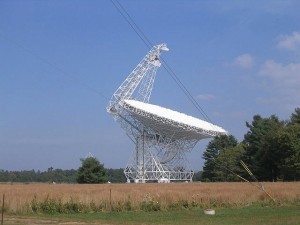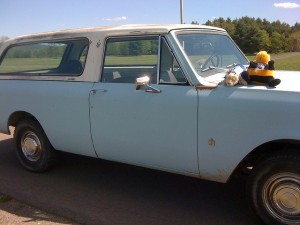Radio astronomy is a different way of looking at the Universe. Literally.
We know that there is only a tiny fraction of the electromagnetic spectrum that we can see with our eyes. It’s a good part of the spectrum, no doubt, as our Sun shines brightest in it, so our eyes naturally would have adapted to use it to see. And there is nothing that can truly replace gazing out on a dark night sky, seeing the Milky Way overhead, with your own eyes. But that view is still limited.
There is another window of the electromagnetic spectrum that is easily observable from the ground, and that’s radio. Some infrared and even ultraviolet light makes its way through the atmosphere, but some of it is obscured and absorbed, so we go to space to do better. The same goes for x-rays and gamma-rays, and a good thing too, since too much of that would be detrimental to life on Earth. But much of the radio spectrum bathes us from space every day, though it now pales in comparison to the gigawatts of power we pump out in wifi and cell phone signals.
There are some places on Earth where you can get away from this signals though, and you have to in order to do very good radio astronomy. I spent a lot of time in Green Bank, West Virginia during my years as a graduate student. It lives in the heart of the “National Radio Quiet Zone.” Good luck getting a cell phone signal out there. And wifi? No way. Bring an ethernet cable. Even microwave ovens can only be used when enclosed in metal shielding so that the massive Green Bank Telescope can see the faint signals of the radio Universe.
I first fell in love with radio astronomy when I worked on my first research project as an undergrad. I analyzed data from 10 different radio dishes spread across the North American continent, imaging some of the tiniest structures on the sky, around, in reality, some of the biggest black holes in the Universe. The very next summer, I got to actually see and work at the Very Large Array in New Mexico, before it got its new electronics and new name. Then I moved to Virginia to do radio astronomy full time, and found myself in Green Bank, one of the first world centers of the field.
There’s something different about a radio dish as compared to an optical telescope mirror. You can climb into and walk around (usually) a radio dish. You get a real feel for the size and power of it. You can link together as many telescopes as you like to do interferometry, and process always partly mysterious to me, even with a knowledge of Fourier transforms, until I had to actually build one. And the history of the field doesn’t go back centuries, like it does for optical astronomy. Some of the greats still walk among us, and those who have left us live on in the stories their students tell.
Radio astronomy has a feel, a history, and a culture all its own, with its own language like “Janskys” and “brightness temperature.” Sure, the lines are blurring, and with new facilities, astronomers of all types are finding themselves working a little in this regime, a little in that, radio just being part of the great continuum of light that we use to probe the cosmos. But I still like the old feel sometimes, like when driving around Green Bank in a 1960s Scout because it is diesel and has no spark plugs, climbing a somewhat shaky ladder in the wind, high above the ground onto a radio dish, worrying over system temperature and *gasp* even using AIPS.
Although my focus now is on education and outreach, my love of radio astronomy is still pretty fierce. So, we’re offering an short online course all about radio astronomy through CosmoAcademy. Some people have expressed interest in learning more about the field, so we’re running it in the hopes that people would like to join in. Though we usually charge a fee for these classes just to pay the instructors, I’m donating my instructor fee to CosmoQuest to keep our awesome citizen science programs going. So you get my time for four hours over two weeks to discuss basic concepts of radio astronomy and learn more all about what those big dishes do. The classes run using Google Hangouts, so the class is capped at eight students. Though I have a good idea of what I want to cover, I’m open to suggestions and will go wherever the students want. That’s a bonus of a small class size.
If you can’t afford the class or just don’t have the time, don’t worry. I’ll still wax poetic about how awesome radio astronomy is through blogging and social media. You all might roll your eyes at me once in a while, but that’s okay. Everyone has to have a passion!
Sign up for the course at Eventbrite. Class starts September 16th, so don’t wait til the last minute!






 Join the Crew!
Join the Crew!
 Escape Velocity Space News
Escape Velocity Space News
You really know your current stuff… Carry on the good function!”